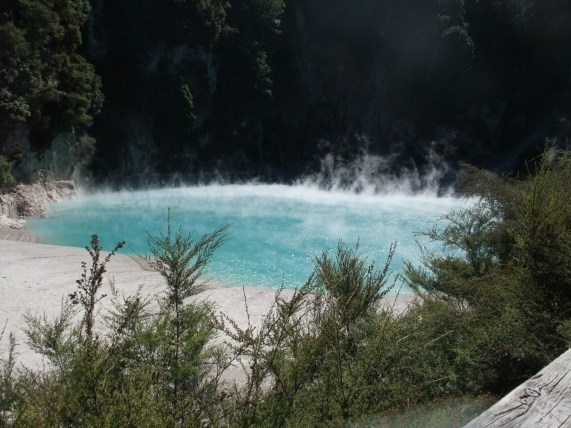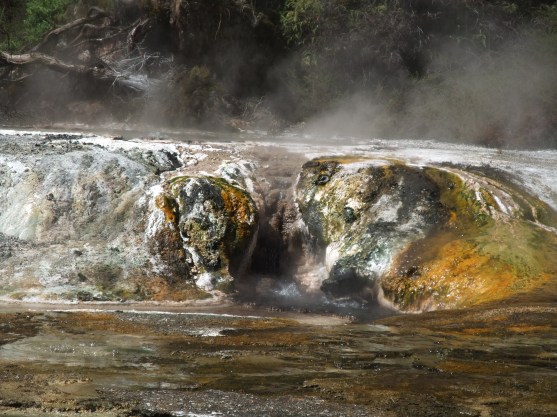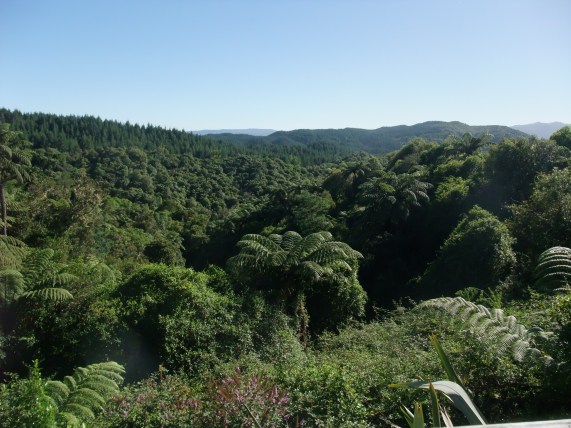This week I’m launching the second Ebook in my Planning to the ‘Nth’ series. Hangi, Haka and Hobbits: Notes from New Zealand, describes my adventures and discoveries while road tripping around New Zealand, just three hours across the Tasman Sea from Australia’s east coast.
To launch the book, I’m offering it free for three days. The offer begins on Saturday 14th May and ends at midnight on Monday 16th. For a free copy of Hangi, Haka and Hobbits: Notes from New Zealand on those days, click here.
This week’s post is an excerpt from the book, just to give a taste of what’s inside. It’s February, 2014, and I’m halfway through winding my way from the Bay of Islands at the top of the North Island down to Wellington at the bottom.
I’m on Highway 5, just out of Rotorua, heading for Waimangu Volcanic Valley. In June, 1886, Mt. Tarawera erupted, coating the land for kilometres around with mud and volcanic ash. All plant and bird life was extinguished. Seven Maori villages near the mountain were buried, with the loss of 120 lives.
The flat land collapsed into a series of craters and Lake Rotomahana exploded to twenty times its original size, filling fifteen of the craters. The marvellous thing about this place is that, being so new, it has provided the opportunity to record, step by step, the development of an entirely new eco-system.
I leave the car in the almost empty car park and enter the modern visitor centre, nestled into a hill, its windows rising to the roof line to catch the light.
‘Just one?’ says the woman behind the counter.
‘Yes,’ I say.
‘Are you interested in the lake cruise as well as the walks?’
‘What time does it leave?’
‘You need to be at the lake at the other end of the track by 1 pm.’ She waits, patiently, while I consider. Not being the world’s fittest person, I don’t want to have to rush to reach somewhere by a certain time.
‘I’ll just do the walks.’
‘That’s $34.50.’ I hand over my travel card, one of the better services designed by the banks, allowing you to spend your travel money without the agony of handing over actual travel money. It’s not that I’m lousy – well, I am a bit – but it’s more that, growing up poor in the fifties, I still retain a little of that idea that if you spend it, you won’t have it anymore, and then what?
‘Now,’ she says, opening a glossy brochure and running her finger along the map. ‘There’s a bus that picks you up, here, here and here, so you can go as far as you like without having to walk all the way back.’
‘Really? Wonderful.’ That is wonderful. There’s always that horrible moment when you’ve happily walked until you’re too tired to walk any further and then realise you have to go all the way back.
The track leads into rain forest, trees towering above and around me, every space between filled with gigantic ferns. The sun filters through the leaves and the fronds, creating lilting shadows on the dirt path. A large hole in the ground appears to my right, filled with greenish water. Surrounded by the greenery of the forest, it looks just like a fairy dell. Dragon flies whirr along the water’s surface. Birds flit from branch to branch and in and out of the undergrowth, and their cheeps are like the chiming of little bells. Are fairies real? If they are, this is where they live.
The first plants returned to the area within months of the eruption, but it took thirty years for the forest to begin to regenerate properly. It’s certainly doing well now. At a lookout, I gaze across tier after tier of forested mountains, soft green morphing into deep blue and then a lighter blue, becoming the sky in the distance. I could be looking over the the Tarkine forests of north-west Tasmania, except without the Arthur River running through.
I drag myself away. The forest opens out and there, before me, is a large lake, steam drifting and wafting from its surface. This is Echo Crater and Frying Pan Lake. On 1st April, 1917, huge steam blasts re-excavated Echo Crater, devastating the surrounding land and destroying an adjacent hotel. Within a month, Frying Pan Lake filled the bottom of the crater, becoming the largest hot water spring in the world.
Creating a backdrop to the lake are Cathedral Rocks, great stacks of lava, not new to the system, but around 60,000 years old, older even than the mountain itself. Steam wafts from gaps in the cliff face, and it’s one of the weirdest things I’ve ever seen. In fact, the whole place has suddenly become something from another era. It only needs a dinosaur to trot past and the picture will be complete.

Past a little spring, joyously popping and bubbling, is a set of steep, stone steps, leading away out of sight. I’m puffing as I reach the top, to be greeted by a spring of a colour between aquamarine and turquoise, bordered on three sides by dark, vertical cliffs.

Inferno Crater is fascinating for its mysterious rhythm. Regularly rising and falling up to 12 metres, it’s a window into the earth’s molten core, and is used for monitoring New Zealand’s volcanic activity. White sinter terraces surrounding the crater, formed by the cooling of the hot geothermal fluids, and vibrantly-coloured algae, mosses and lichens, only add to the beauty of the scene.
‘It’s worth it,’ I say to a woman, on her way up the steps as I’m coming down. She glances at me but is puffing too much to reply. Perpendicular cliffs tower above me as I wander along the track. Mud pools plop and pop. A little steaming, gurgling stream follows me for a while, as if keeping me company.

The forest opens out again and I stand for awhile, gazing at the Marble Terraces. Stripes of white, a rich gold, brown and emerald green remind me of a modernist painting, one of those in which you can’t work out what the artist is telling you but you like it for its colours.

I relax onto the wooden seat at Bus Stop 2. The little stream has reappeared and gurgles past. A myriad of bird cheeps, chirrups, twitters and an actual little tuneful motif, vie for my attention. I have to return here, not immediately, but sometime in the future. Next time I will definitely do the lake cruise. I have a strong feeling I’ve missed out badly there.
Hangi, Haka and Hobbits: Notes from New Zealand is book two in my Planning to the ‘Nth’ travel series. To download a free sample from Amazon, or to buy the book, click here.
The Edge of the World: Next Stop Cape Horn is book one in the series. To download a copy, click here.




Great post and pictures, Coral. I felt as if I was there with you.
LikeLike
Thanks, Glenice.
LikeLike
Sounds amazing and the photos are stunning Coral.
LikeLike
Thanks, Miriam.
LikeLiked by 1 person
Congratulations on your book. It does sound a great read…pictures are awesome too (loved reading about the Crater) 🙂
LikeLike
Thanks very much, Alok. It’s a gorgeous spot.
LikeLike
Wow congrats on your book!
LikeLike
Thanks so much, Rashminotes.
LikeLike